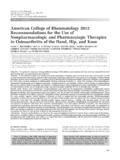Transcription of New Immunotherapies: Management of Immune Related …
1 New immunotherapies : Management of Immune Related Adverse Events Dr. Margaret Smith General Practitioner in Oncology Dr. Margaret Smith: None Dr. Kerry Savage: Advisory Board Memberships: BMS, Merck, Seattle Genetics Grants/honorariums received: BMS, Merck, Seattle Genetics, Infinity Clinical trial participation within the past 2 years: BMS, Seattle Genetics Declaration of Conflict of Interest At the end of this workshop, participants will be able to: Describe the mechanism of action of the new immunotherapies : PD-1 and CTLA-4 Immune Checkpoint Inhibition currently approved and in use in BC Describe the difference between the new immunotherapies and targeted therapies for treatment of metastatic cancer. Identify and effectively carry out surveillance of Immune - Related adverse events (irAEs) and toxicities of these therapies Institute appropriate treatment and Management of irAEs associated with these therapies Objectives Actual irAEs from VICC patient cases over the past year will be discussed.
2 Approval and use of these therapies in British Columbia is new: we are essentially in a Phase IV post marketing survey with these agents We are all learning and gaining experience with these agents as they come in to use locally: Oncologists, GPO s, support specialists: nephrologists, gastroenterology, endocrinology and more. Which of the following are Immune Related adverse events associated with ipilumumab: a) vitilago b) colitis c) neuropathy d) pituitary failure e) lymphadenopathy f ) all Emergence of Immune Related adverse events from checkpoint inhibition may correlate with treatment response: true false unknown at this time Which of these tumors have current Canada Health Approval for use of Checkpoint Inhibition therapy: a) melanoma b) advanced stage ovarian/fallopian tube carcinoma c) advanced renal clear cell carcinoma d) pancreatic carcinoma e) advanced non-small cell lung cancer Which of the following are targeted therapies for melanoma: a) ipilimumab b) vemurafenib c) nivolumab d) pertuzumab e) dabrafenib/trametinib First Things First.
3 Basic Immunology to Understand Checkpoint Inhibition Thanks to various contributors for graphics on T Cell Immune Theory T cells are thought to play an important role in Immune surveillance and tumor destruction. Immune response regulation is built into our T cell Immune system to prevent bystander tissue damage Cytokines, T reg cells, and cosignalling molecules are some of the mechanisms that limit the strength and extent of the activated T cell s Immune response T cell therapy How Do T-cells Recognize and Kill Tumour Cells? Tumours express tumour-associated antigens1,2 Antigen 1. Mellman I. Nature. 2011;480:480-89; 2. Heemskerk B. EMBO J. 2013;32(2):194-203. Antigen presenting cell (APC) captures tumour-associated antigens2 APC presents the tumour-associated antigen to an inactive T-cell, along with a co-stimulatory signal2 Co-stimulatory signal Antigen Cytotoxic T-cell induces tumour cell death by apoptosis1,2 Inactive T-cell T-cell becomes activated and binds to tumour cell Cytotoxic T-cell 12 There are many potential sites for checkpoint receptor inhibition Tumour Immune suppression Tumour cells can escape from Immune system destruction through many mechanisms, including the expression of Immune suppressive molecules on their cell surface Tumour Cells PD-L1 Tumour Antigen Mellman et al.
4 Nature. 2011;480:480-9. 16 Tumour Immunosuppression Mellman et al. Nature. 2011;480:480-9. Tumour cells can escape from Immune system destruction through many mechanisms, including the expression of Immune suppressive molecules on their cell surface 1. Activated T-cells Activated T-cells go to tumour site Able to recognize and destroy tumour cells Have PD-1 on their surface Tumour Cells PD-1 PD-L1 Tumour Antigen 17 Tumour Immunosuppression Mellman et al. Nature. 2011;480:480-9. Tumour cells can escape from Immune system destruction through many mechanisms, including the expression of Immune suppressive molecules on their cell surface 2. PD-1 on T-cells binds to PD-L1 on tumour cells Tumour Cells PD-1 1. Activated T-cells Activated T-cells go to tumour site Able to recognize and destroy tumour cells Have PD-1 on their surface PD-1 PD-L1 18 Tumour Immunosuppression Mellman et al.
5 Nature. 2011;480:480-9. Tumour cells can escape from Immune system destruction through many mechanisms, including the expression of Immune suppressive molecules on their cell surface 2. PD-1 on T-cells binds to PD-L1 on tumour cells 3. T-cells are inactivated = Immunosuppression Tumour Cells PD-1 1. Activated T-cells Activated T-cells go to tumour site Able to recognize and destroy tumour cells Have PD-1 on their surface PD-1 PD-L1 19 How Does Anti-PD-1/PD-L1 Therapy Work? Mellman et al. Nature. 2011;480:480-9. Tumour Cells PD-1 PD-L1 Anti-PD-1 or Anti-PD-L1 Antibody Anti-PD-1 or anti-PD-L1 antibody therapy blocks the interaction between PD-1 and PD-L1 20 CTLA-4 regulation occurs centrally in the lymph node where there is initial response to the tumor antigen PD-1 regulation and response occurs in the peripheral tissues where it binds to PD-1 ligand, which is overexpressed on some tumour cells CTLA4 and PD-1 are Immune checkpoint inhibitors CTLA4: cytotoxic T-lymphocyte-associated antigen 4; DC: dendritic cell; MHC: major histocompatibility complex; PD-1: programmed cell death protein-1; TCR: t-cell recptor.
6 Pardoll DM. ;12:252-64. Immune checkpoint inhibitors maintain self-tolerance and modulate the duration and amplitude of Immune responses CTLA4 regulates initial response to antigen PD-1 regulates response in tissues Major Role 22 Examples of targeted therapy receptors: BRAF (vemurafenib) VEGF (bevacizumab) HER2 (trastuzumab) PDGFR (sorafenib, sunitinib) KRAS (panitumumab) Targeted Immune therapies are different from Checkpoint Inhibition therapies Why all the interest in Checkpoint Inhibitor Immune therapies ? They bring new hope of effective treatments in tumor sites that previously had little or no success with systemic therapies NEJM May 21, 2015 Michael A Postow et al Untreated Melanoma NEJM Nov 5, 2015 Nivolumab vs everolimus in metastatic renal cell cancer NEJM Nov 5 2015 Motzer et al 010203040506070809010003691215182124 Nivolumab CheckMate 017: PFS in advanced non small cell lung cancer Brahmer et al, NEJM May 21, 2015 CI: confidence interval; HR: hazard ratio; PFS: progression-free survival.
7 Brahmer et al. N Eng J Med. 2015;373:123-35. Nivolumab 135 68 48 33 21 15 6 2 0 Docetaxel 137 62 26 9 6 2 1 0 0 Nivolumab n=135 Docetaxel n=137 Median PFS, months (95% CI) ( ) ( ) HR= (95% CI: ); p< Nivolumab Docetaxel 1-yr PFS rate=21% 1-yr PFS rate= Number of Patients at Risk Time (months) PFS (%) Phase III 29 Pembrolizumab in NSCLC KEYNOTE-010: OS Pembro 2 mg/kg n=345 Pembro 10 mg/kg n=346 Docetaxel n=343 Median OS, months (95% CI) ( ) ( ) ( ) HR vs. docetaxel ( ); p= ( ); p< 010203040506070809010005101520252 mg/kg 344 259 115 49 12 0 10 mg/kg 346 255 124 56 6 0 Docetaxel 343 212 79 33 1 0 OS (%) Time (months) CI: confidence interval; HR: hazard ratio; OS: overall survival. Herbst et al. Lancet. 2015 Dec 19. [epub ahead of print]. Number of Patients at Risk Pembro 2 mg/kg Docetaxel Pembro 10 mg/kg 1-yr OS rate= 1-yr OS rate= 1-yr OS rate= Phase II/III 30 Anti-PD-1/PD-L1 Drugs in Development* Target Antibody Developmental Stage PD-1 Nivolumab Phase III: multiple tumours Health Canada approved: melanoma, advanced RCC and NSCLC FDA approved: melanoma, NSCLC, advanced RCC, and cHL Pembrolizumab Phase III: multiple tumours Health Canada approved: melanoma and NSCLC FDA approved: melanoma and NSCLC PD-L1 Atezolizumab Phase I/II: multiple tumours.
8 Phase III: bladder, NSCLC FDA breakthrough status in lung cancer FDA approved: urothelial carcinoma Avelumab Phase I: multiple tumours, Phase III: NSCLC FDA breakthrough status in MCC Durvalumab Phase I/II: multiple tumours Phase III: NSCLC, HNSCC, bladder FDA breakthrough status in urothelial carcinoma cHL: classical Hodgkin lymphoma; HNSCC: head and neck squamous cell carcinoma; MCC: Merkel cell carcinoma; NSCLC: non-small cell lung cancer; RCC: renal cell carcinoma. *Developmental stage as of May 21, 2016. 32 Immune - Related Adverse Events While Immune checkpoint inhibition has resulted in anti-tumour responses, toxicities in the form of autoimmune breakthrough or Immune - Related adverse events (irAEs) have also been reported. oEven seemingly unimportant symptoms can escalate, causing serious life threatening complications if left unmanaged oClose and careful patient monitoring is critical oMost irAEs are mild to moderate in severity and can be medically managed using corticosteroids Villadolid and Amin.
9 Trans Lung Cancer Res. 2015;4:560-75. 33 For patients with Grade 1 (mild) toxicity, proceed with caution, surveillance. For Grade 2 (moderate) irAE toxicity: withold the checkpoint inhibitor until symptoms resolve, or toxicity is grade 1 or less. Corticosteroids should be started (prednisone 1 mg/kg/day) if grade 2 symptoms persist beyond than 1 week. For Grade 3 or 4 irAE toxicity (severe to life threatening): Permanently discontinue the Checkpoint inhibitor. High dose corticosteroids until symptoms subside to grade 1 or less, then begin a slow steroid taper over at least 1 month. UpToDate: Toxicities associated with checkpoint inhibitor immunotherapy 2016 irAE s: General Guidelines Pseudo-progression A Clinical Challenge with Immune therapies Historically, significant tumour growth ( , by RECIST or WHO criteria) would be classified as treatment failure However, some patients on immunotherapies appear to have progressive disease after starting treatment oTumour appears larger on initial CT scans oIncreased tumour size actually due to infiltration of Immune cells or necrosis is followed by decreased tumour burden Continue to treat through this pseudo-progression , and reassess one month later Each patient must be monitored carefully on an individual basis with repeat assessments Some patients may have true progressive disease and may consider alternate treatment options CT: computed tomography.
10 Chiou and Burotto. JCO. 2015;33:3541-3. 38 Checkpoint Inhibitor therapy is expensive! Ipilimumab: about C$100,000 for the 4 treatments Nivolumab: estimated C$14,526 per 28 days (final Canadian price pending) Pembrolizumab: estimated C$8,213 per 28-days (2 mg/kg Q3W) Docetaxel: approximately $583 per 28 day course - Erlotinib: $2240 per 28 day cycle 39 Let s get to some actual cases of Immune Related adverse events from the Vancouver Island Cancer Clinic in the past year Ms. GV: 59 year old woman dignosed with Stage IV non-small cell lung cancer; dominant mass RUL to LUL, R hilum, mediastinal lymphadenopathy June 2013. EGFR and ALK untested due to insufficient tissue, diagnosis on FNA of RUL mass 2013 progression after 2 cycles of pemetrexed and cisplatin, then further progression after 4 cycles of erlotnib.
















